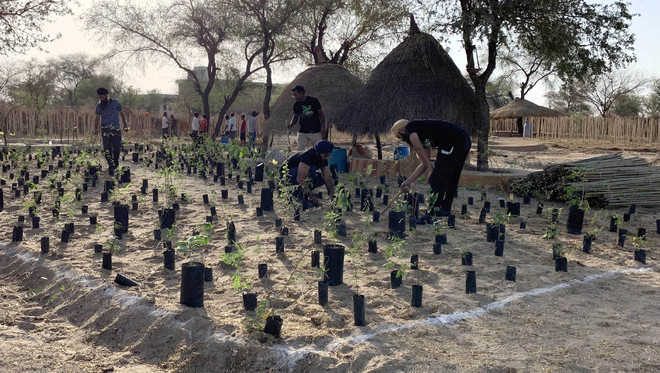‘Nanak jungles’ to increase state’s green cover
Aparna Banerji
Tribune News Service
Jalandhar, July 1
In order to rescue the depleting groundwater and increase the minuscule forest cover of the state (3.52), the Punjab Forest Department and Eco Sikh organisation have adopted the Miyawaki method, popularised by Japanese botanist Akira Miyawaki. Saplings of 64 rare species are being planted on a war-footing to revive the forest cover of the state.
While the Forest Department has already planted Guru Nanak Pavittar Jungles (Guru Nanak Sacred Jungles) at 2,000 villages (of the total 12,800) in the state, where 11 lakh trees have been planted.
The team of the Eco Sikh has 15 key mobilisers working across the state to plant “Nanak Bagichis”. Planted in spaces ranging from 180 sq ft (smallest place required for a Miyawaki forest) to a one acre forest in Jagraon, the Eco Sikh has already planted 14 forests in the state as per the method apart from additional plantations of 550 trees (per village) in various villages.
While the organisation, which is the knowledge partner of the state government on the Miyawaki project, began plantation drives across the world last year, setting a target of planting lakhs of trees until the time of the Guru Nanak birth anniversary celebrations this year, actively adopted the Miyawaki project in March this year, seeing its viability and effectiveness in small spaces.
Pavneet Singh, Assistant Manager, Eco Sikh, said, “The Guru Nanak Sacred Jungles are part of an exhortation to people to adhere to the teachings of the Guru and achieve a greener state by the 550 Parkash Utsav. The state’s groundwater is in deep crisis and it shall help to alleviate that. Two months ago we planted four forests in a month. This month we planted six and we expect to considerably pick up speed.”
Principal Chief Conservator of Forests Jatinder Sharma said, “Punjab’s forests are 6.8 per cent of the total geographical area in the state. There are space and change of land use constraints with 84 per cent of the state under crop cover. Compared to 35 lakh trees planted by farmers in 2018-19, we hope to plant over 75 lakh trees in 2019-20 under the project. With the closed-density method, monsoons shall set in motion rapid growth of many of the recently planted saplings.”









